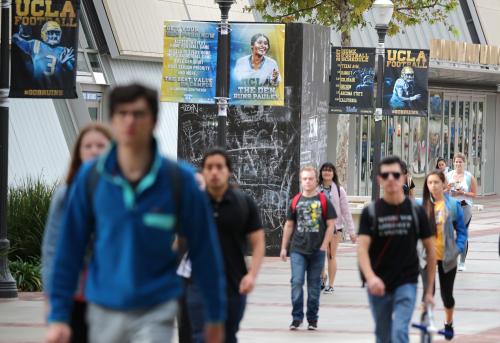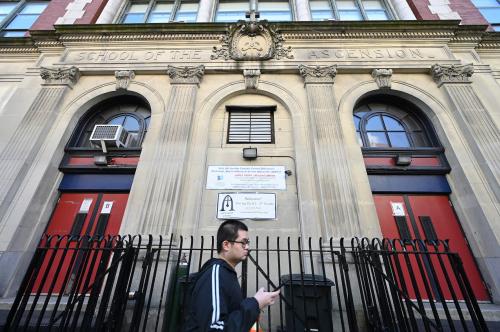A recent Wall Street Journal article tells a startling tale of a University of Southern California dental school graduate who owes more than a million dollars in student debt—a balance he will never fully repay. While he is exceptional—only 101 people out of 41 million student-loan borrowers owe more than a million dollars—his case highlights the flaws in a student-loan program that offers graduate students and parents unlimited access to federal loans and generous repayment plans. The result: Well-endowed universities and well-paid, well-educated borrowers benefit at the expense of taxpayers and less well-off students.
While borrowers with large balances are not typical, they account for a growing share of all student loans. A third of all student loan debt is owed by the 5.5 percent of borrowers with balances above $100,000—and more than 40 percent of these are enrolled in income-based repayment plans that mean they may not have to pay back all the money they borrowed. Thanks to a 2006 law, graduate students may borrow not only the cost of tuition but also living expenses while they are in school. Income-based repayment plans cap borrower’s payments at 10 percent of their discretionary income (adjusted gross income minus 150 percent of the poverty line—$37,650 for a family of four) and forgive any remaining balance after 25 years.
That means that Mike Meru, the orthodontist in the WSJ story, who earns more than $255,000 a year, owns a $400,000 house and drives a Tesla pays only $1,589.97 a month on his student loans. In 25 years, his remaining balance, projected to exceed $2 million given accumulating interest, will be forgiven. The combination of unlimited borrowing and generous repayment plans produces a windfall for both USC and large borrowers.
While borrowers with large balances are not typical, they account for a growing share of all student loans.
In Dr. Meru’s case, the federal government paid USC tuition of $601,506 for his education, but he will only pay back only $414,900 in present value before his debt is discharged.[1] (Present value is the value today of a stream of future payments given an interest rate. Because most of Mr. Meru’s payments occur far in the future, comparison of his future repayments to the tuition paid to USC requires using the present value.)
The fact that federal government is paying USC far in excess of what it is going to get back from the borrower illustrates the problem with letting graduate students and parents borrow unlimited amounts while discharging residual debt in the future. In this case, USC (with an endowment of $5 billion) has no incentive to keep its costs down. It could have charged the student an even higher amount and it would not have affected the borrower’s annual payments or the total amount he paid. When William Bennett, then secretary of education, said in 1987 that “increases in financial aid in recent years have enabled colleges and universities blithely to raise their tuitions, confident that Federal loan subsidies would help cushion the increase”—this is exactly what he was talking about.
The borrower does well, too. Despite earning $225,000 each year—and almost $5 million (again, in net present value) over the course of his loan payments—Dr. Meru will pay back only $414,900 on a $601,506 degree. Because the balance of the loan is going to be forgiven, neither he nor the school cares whether tuition is too high or whether to rack up a bit more interest delaying repayment.
So who loses? The obvious one is the American taxpayer because the shortfall must come out of the federal budget. Indeed, for “consolidated” loans like Dr. Meru’s, the Department of Education assumed it will lose $28.70 on each $100 in debt enrolled in income-driven repayment plans. But the less obvious victims are other federal aid recipients. Historically, Congress has worked to contain the overall cost of the student loan program, in part using repayments of principal plus interest to offset any losses from low-interest, defaulted, unpaid, or forgiven loans. In that system, the higher interest rates and stronger performance of graduate loans helped offset costs of subsidized loans to low-income undergraduates. That could be unwinding.
Today, most borrowers who default owe less than $10,000 from attending a lower-cost undergraduate institution. The government collects from them not just their loan balances, but also fees and penalties by garnishing their wages and taking their tax refunds. But even under income-based repayment plans, most low-balance, undergraduate borrowers will repay in full—there is little federal subsidy for these borrowers. The biggest beneficiaries of these programs are, instead, graduate borrowers with the largest balances. And to the extent that unlimited borrowing for graduates (and for the parents of undergraduates) boosts tuition, that hits everyone who pays back their loans or pays out of pocket.
Income-driven repayment is a good way to insure borrowers against unexpected adversity after leaving school. But absent other reforms, it exacerbates other problems in the student loan market. In the Wall Street Journal’s case study, unlimited borrowing, capped payments, and discharged debt looks more like a subsidy for tuition, benefiting successful graduate borrowers and insulating high-cost or low-quality schools from market forces.
Education remains a critical doorway to opportunity. Students of all backgrounds should have access to high-quality schools, and the federal student loan system should be designed to make that possible.
A better system would limit the credit available to graduate and parent borrowers and ask higher-income borrowers to repay more of their loan balance. It could also strengthen institutional accountability systems such that schools had a greater stake in their students ability to repay loans—for instance, tying loan eligibility or financial incentives to the repayment rates of their borrowers.
*This post has been updated to correct an error in the number of borrowers with balances over $100,000 and the share of loan debt they owe.
[1] This calculation assumes discounts Mr. Meru’s payments to 2014, his first year after graduation, that his payments under his income-driven repayment started in 2015, and that he pays 10 percent of his annual discretionary income (salary minus 150 percent of the federal poverty line for a family of four) for 25 years. I assume his salary was $225,000 in 2017 and increases by 3.1 percent annually (the average rate assumed in the Congressional Budget Office’s economic projections). I discount all cash flows at a 3 percent rate (the 20-year Treasury rate). This calculation excludes potential tax consequences of the discharge after 25 years. However, even assuming the discharge were taxable in full—which is unlikely—Meru’s total payments would barely exceed tuition payments.
The Brookings Institution is committed to quality, independence, and impact.
We are supported by a diverse array of funders. In line with our values and policies, each Brookings publication represents the sole views of its author(s).






Commentary
Why the dentist with $1 million in student debt spells trouble for federal loan programs
May 30, 2018